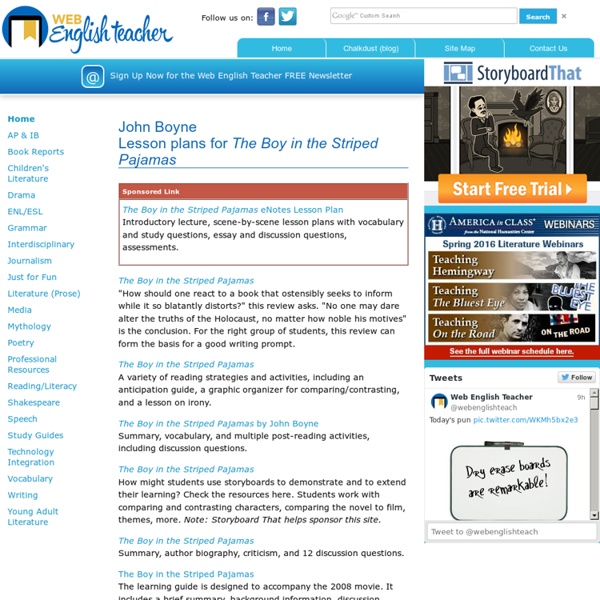The Boy in the Striped Pajamas Lesson Plans

The Boy in the Striped Pajamas Lesson Plan - Lesson Plan
Chapter 1 Vocabulary chaos: disorder, clutter, confusion dismissively: in a way that shows a lack of interest hesitate: pause as the result of feeling reluctant to proceed mucky: dirty possessions: belongings “the Fury”: Bruno’s mispronunciation of the Führer, referring to Adolf Hitler, the German chancellor Chapter 1 Study Questions 1. “Fury” is Bruno’s mispronunciation of the word “Führer,” Adolf Hitler’s title when he was Germany’s leader. 2. We know that Bruno is a child. 3. Bruno knows very little about his father’s job, but he does know that he is “a man to watch” and that “the Fury” “had big things in mind for him.” 4. Bruno is especially upset to be leaving his three best friends behind. 5. Bruno mentions that he doesn’t like that they have to turn off all the lights at night. Chapter 2 Vocabulary chalk it up: give credit for courgette: British zucchini desolate: lonely, empty foreseeable: as far into the future as one can see, as far as can be predicted, as far as we know 1. 2. 3. 4. 5.
Vårens arbete med Allmänna råden för planering och genomförande
I början av detta läsår skrev jag här på bloggen om det arbete vi gjort med att all personal fick beskriva vår skolas undervisningskultur i juni-15. Utifrån vad vi fick syn på i personals beskrivningar blev en ”åtgärd” att vi, under läsåret 15-16, skulle arbeta med Skolverkets Allmänna råd för planering och genomförande. (Under ht15 fördjupade vi oss i Lgr11 kap2, finna att läsa i detta blogginlägg). Vi köpte hem ett stort antal ”råd” så att all personal kunde få den analogt (förutom att ha den digitalt nedladdad i sina iPads). Skolverket har gjort en kort, informativ film, som beskriver upplägget och innehållet i råden: Vi inledde arbetet i januari med en gemensam samling för all personal. ”Backa bandet” ”zooma ut” (många nyanställda lärare)Hitta samstämmighet i uppdrag, lära av och med varandraSynliggöra våra bilder av uppdrag med varandra I vårens kalendarie satte vi även ut speciell ”Allmänna-råd-tid” (både mötestid på em samt på studiedagar). Fler klipp hittar du här. Tillägg:
Bildspråk - Presentation by Annika Sjödahl
En deckarhistoria med digitala verktyg
Mina åttor har läst olika typer av deckare, bland annat Man kan bara bli hängd en gång och Ridån går upp. Den senare blev de mycket fästa vid och gav dessutom ett bra diskussionsunderlag. Vanligtvis skriver eleverna egna deckare, men tiden är knapp så här i slutet av terminen. Istället för att skriva en hel och omfattande deckare, blev alternativet att gestalta sig själv som huvudperson i valfri deckargenre. Välja karaktär: Pusseldeckarens smarta detektiv, en hårdkokt snut, en psykopat eller varför inte en mix av alla? För att skapa en interaktiv deckarhistoria behöver du: En selfie och googlade bilder.Alfafunktionen i Pages. Tiden då?
Voto.se
Related:
Related:



